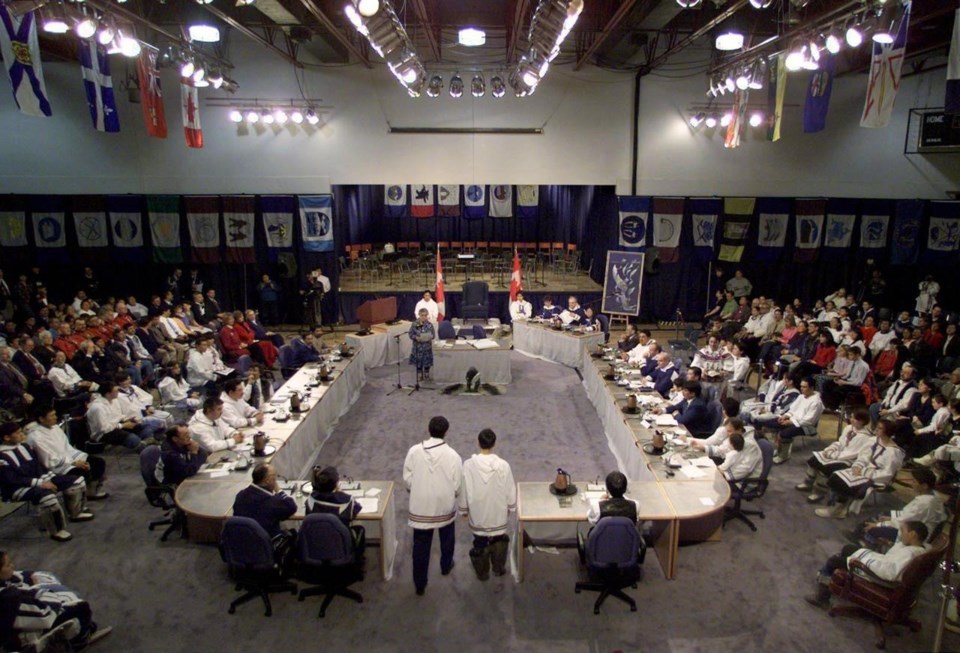IQALUIT, Nunavut ÔÇö P.J. Akeeagok was a teenager in a tiny hamlet on the tip of Ellesmere Island, watching with anticipation when Nunavut was officially born.┬á
Twenty-five years later, he is the premier of Canada's youngest territory.
"There was so much excitement, so much optimism in the air,ÔÇŁ Akeeagok recalls of the time around April 1, 1999, when the map of Canada was redrawn to carve Nunavut out of the eastern half of the old Northwest Territories.
ÔÇťBut we weren't sure what it really was. I was young at the time, but there was something special going on."
Akeeagok lived in Grise Fiord, was a sergeant with the Junior Canadian Rangers and dreamed of serving his community. At the time, he thought heÔÇÖd become a water truck driver.
ÔÇťI had no idea at the time, obviously, that I would become premier one day,ÔÇŁ he says.┬á
The 39-year-old says itÔÇÖs both an immense responsibility and privilege to continue steering the territory towards the vision behind NunavutÔÇÖs formation.
The creation of Nunavut -- which means "Our land" in Inuktitut -- was part of a land claim settlement, the first major change to CanadaÔÇÖs map since Newfoundland and Labrador joined Confederation in 1949. It extends from the 60th parallel to the northern coast of Ellesmere Island, about one-fifth of Canada's land mass.┬á
After more than a decade of negotiation, the Nunavut Act and the Nunavut Land Claims Agreement Act received royal assent in 1993. Residents celebrate Nunavut Day every July to mark the passing of the legislation that promised the new territory and a public government. 
"We are forging a new partnership, a real partnership,ÔÇŁ said then-prime minister Brian Mulroney at a signing ceremony.┬á
Solomon Awa remembers he was out hunting in Pond Inlet, a small community on northern Baffin Island, when the territory came into existence six years later. Once the hunt was over, the impact of what was going on started to sink in.
ÔÇťWe have our own government, territory government," Awa says.
A quarter century later he is the mayor of Iqaluit, the territoryÔÇÖs capital city. A lot has changed in that time, Awa says, including rapid growth.┬á
"ItÔÇÖs still growing very fast,ÔÇŁ he says.
NunavutÔÇÖs population, about 85 per cent Inuit, has been steadily increasing. It's now more than 40,000 people from fewer than 30,000 in 1999.
Four active mines provide significant employment, and Akeeagok says they are looking at tapping other resources, including fisheries. 
A lot more opportunities are also expected after the territory inked a historic devolution agreement with Ottawa earlier this year. It will transfer powers over public lands, waters and non-renewable resources to the territory.
AwaÔÇÖs brother Simon was Nunavut's chief negotiator of devolution. The mayor says their family faced many hardships, but their elders always instilled wisdom that pushed many of his siblings to serve the people of the territory.
ÔÇťWay back to the great-great grandparents ... that if you move forward you are going to achieve something,ÔÇŁ Awa said.
The work of NunavutÔÇÖs forbearers and the progress of the last 25 years will be celebrated with fireworks, entertainment and a cultural showcase on Monday. Gov. Gen. Mary Simon is scheduled to be in attendance.
Akeeagok says he hopes it inspires pride in young Nunavummiut. 
ÔÇťThey are the ones who will take our territory forward.ÔÇŁ
That future does not come without challenge. Both leaders say housing in the territory is at a crisis. 
ThereÔÇÖs long been issues with overcrowded housing in the territory, which has worsened with population growth and workers coming in for jobs. Inadequate housing is also linked to other issues like poor education outcomes and health problems, including increased risk of suicide.
ÔÇťWhen you live in overcrowded housing it really does impact you,ÔÇŁ Akeeagok says. ÔÇťSo, we've really put our single largest investments into housing."
As the young territory marks this significant milestone, Akeeagok is certain that determination and the spirit of Nunavut will ensure things continue to improve. 
The premier often thinks of the advice he received from those who helped create the territory: be grounded.
"Have that long-term vision and not to make swift quick changes of the flavour of the day,ÔÇŁ he says.┬á
ÔÇťJust always live up to the imagination of what the Nunavut Agreement was to become."
This report by The Canadian Press was first published March 31, 2024.
ÔÇö By Kelly Geraldine Malone in Saskatoon
The Canadian Press




